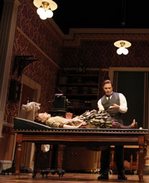SITE GUIDE
SEARCH
REVIEWS
REVIEW ARCHIVES
ADVERTISING AT CURTAINUP
FEATURES
NEWS
Etcetera and
Short Term Listings
LISTINGS
Broadway
Off-Broadway
NYC Restaurants
BOOKS and CDs
OTHER PLACES
Berkshires
London
California
New Jersey
DC
Connecticut
Philadelphia
Elsewhere
QUOTES
TKTS
PLAYWRIGHTS' ALBUMS
LETTERS TO EDITOR
FILM
LINKS
MISCELLANEOUS
Free Updates
Masthead
A CurtainUp Review
In the Next Room
or the vibrator play
By Elyse Sommer
|
What men do not see because their intellect prevents them from seeing would fill many books.— Dr. Givings, who himself fails to see what his vibrator treatments are really treating, and recognizing that their effect on his patients has awakened not just his wife's curiosity but aroused her own need to see and be seen fully.
|

Michael Cerveris as Dr. Givings giving a vibrator treatment
(Photo: Joan Marcus) |
In the Next Room may not have the wattage to sustain its overload of ideas and plot developments, but no matter. A superb cast makes the most of the fun. The scenery and costumes are gorgeous. The titillation and the double entendres sprinkled into the script as if it were an ice cream cone get laughs without ever descending into pornography (though I wouldn't suggest bringing the kids). Even though this is an atypically realistic play for Ruhl, she and director Les Waters have managed a fabulous fantastical finale that's lyrical enough to make its heavy dose of syrup palatable.
In keeping with the title, Ruhl's drawing room continually shares the stage and our attention with the room next to the well-appointed parlor of the Givings home in a spa town (similar to Saratoga Springs) circa 1880. It is this in this "next room" that Dr. Givings (Michael Cerveris, the actor best known for his musical roles is beguilingly bland as the husband in need of his own getting-in-touch treatment) uses the new-fangled electrical appliance that gives the play its subtitle to treat hysterical patients. But it it takes his young wife (Laura Benanti, as deliciously ditzy as she is delectably lovely) to lead the good doctor towards making a connection between his patients' hysteria and their frustrating lights-out-eyes closed sexual lives. The curiosity aroused from seeing the effect of those treatments on the patients leaving that next room stirs Mrs. Givings' own need to see and be seen fully. It's inevitable that this will eventually work its magic for Doctor and Mrs. Givings—the surprise being not if, but how and when.
With doctors having pretty much moved their practices out of their homes, Mrs. Givings nowadays would not have a chance to meet and befriend her husband's patients as she does here, or eavesdrop on what goes on in his office, which she also does as well. But then she'd probably be too busy with a job of her own. Some psychiatrists still have offices in their homes and if the popular In Treatment TV series is an indication, this setup can wreak havoc with the doctor's personal life as as well as that of his patients. At any rate, Mrs. Givings despite being the mother of a much wanted new baby IS frustrated and bored as well as curious, lively and outspoken in a decidedly un-Victorian way.
And so the needy young wife and mother befriends Mrs. Daldry (Maria Dizzia, even more of a standout than she was as the title character of Ruhl's Euridyce) who enters the treatment room, pale and a bundle of nervous ticks. She hates light, cries easily, has stopped playing the piano she once loved. Worst of all is the situation in the Daldry's marital bed. As her husband (Thomas Jay Ryan, an actor whose ability to inhabit all manner of chracters seems limitless) genteely puts it, "I am afraid there is very little sympathy between us."
Happily, Mrs. Daldry is quickly restored to good spirits and eager to continue the vibrator treatments which are not limited to the doctor's own carefully timed and strictly scientific applications. Annie (a sensitive and touching performance by Wendy Rich Stetson), Givingss able spinster assistant is called to the "operating table" and, once they become friends and conspirators determined to learn more about the magical machine, Mrs. Daldry and Mrs. Givings also have a go at it. Oh, there's also a male patient —Leo Irving (an extemely amusing Chandler Williams), a dashing artist in need of nerve calming after a gone-wrong affair.
The sub-plots seeded by the main subject of the stultifying Victorian mores that caused the symptoms bringing patients to the well-intentioned but emotionally clueless Dr. Givings add some striking and quite touching moments. However, they tilt a bit too much towards farce and the already mentioned circuitry overload. First of these plots revolves around the frustrations that still affect mothers who don't have sufficient milk to breastfeed successfully.
Mrs. Givings' lack of milk to feed her baby allows Ms. Ruhl to examine the practice of using wet nurses through a new character, Elizabeth (Quincy Tyler Bernstine, the only actor who seems a bit out of her element in this cast), a black married woman whose own baby died. Mrs. Givings is grateful to Mr. Daldry for introducing her and the Doctor to Elizabeth, but not enough to accept quite another offer from this gentleman. She's also pained over the bond thus formed between a stranger and her child.
The additional plot threads involving Mrs. Givings, the sexy painter and Elizabeth are not particularly organic to the plot. They do add enjoyable dabs of color. And speaking of color, a word about Annie Smart's scenery. True to her name, this designer has managed to create an authentic Victorian parlor, but in keeping with the electricity that's just beginning to cast the world in a bright new light, she's done so with a cheery look rather than the somberness common to this era's look. The attention to authentic detail and color are supported by David Zinn's costumes for the men as well as the women, with the women's skirt's several times used to good effect for the under-the-sheets discretion with which the vibrator treatments are administered
To sum up In the Next Room in a Tweet: Like one of those heaping portions offered at some restaurant chains. Not quite as nourishing as they look but enjoyable enough to stimulate one's appetite.
Links to other Sarah Ruhl Plays:
The Clean House
Eurydice Dead Man's Cell Phone
|
In the Next Room or the tibrator play By Sarah Ruhl. Directed by Les Waters. Cast: Laura Benanti (Mrs. Givings), Michael Cerveris (Dr. Givins), Maria Dizzia (Mrs Daldry), Thomas Jay Ryan (Mr. Daldry), Quincy Tyler Bernstine(Elizabeth), Chandler Williams (Leo Irving), Wendy Richestetson (Annie) Sets: Annie Smart Costumes David Zinn. Lighting: Russell H. Champa. Sound: Bray Poor. Music by Jonathan Bell. Stage Manager: Roy Harris Running Time: 2 hours 25 minutes, including one 15 minute intermission Theatre: Lincoln Center Theater at the Lyceum Theatre, 149 West 45th Street between Broadway and 6th Avenue Schedule: Tuesday at 7 pm, Wednesday through Saturday at 8 pm, Wednesday and Saturday at 2 pm, Sunday at 3 pm Tickets: $51.50 to $96.50 From 10/22/09; opening 11/19/09 Reviewed by Elyse Sommer November 21st |
|
REVIEW FEEDBACK Highlight one of the responses below and click "copy" or"CTRL+C"
Paste the highlighted text into the subject line (CTRL+ V): Feel free to add detailed comments in the body of the email. . .also the names and emails of any friends to whom you'd like us to forward a copy of this review. You can also contact us at Curtainup at Facebook or Curtainup at Twitter |
|
Subscribe to our FREE email updates with a note from editor Elyse Sommer about additions to the website -- with main page hot links to the latest features posted at our numerous locations. To subscribe,
E-mail: esommer@curtainup.comesommer@curtainup.com
put SUBSCRIBE CURTAINUP EMAIL UPDATE in the subject line and your full name and email address in the body of the message -- if you can spare a minute, tell us how you came to CurtainUp and from what part of the country. |






